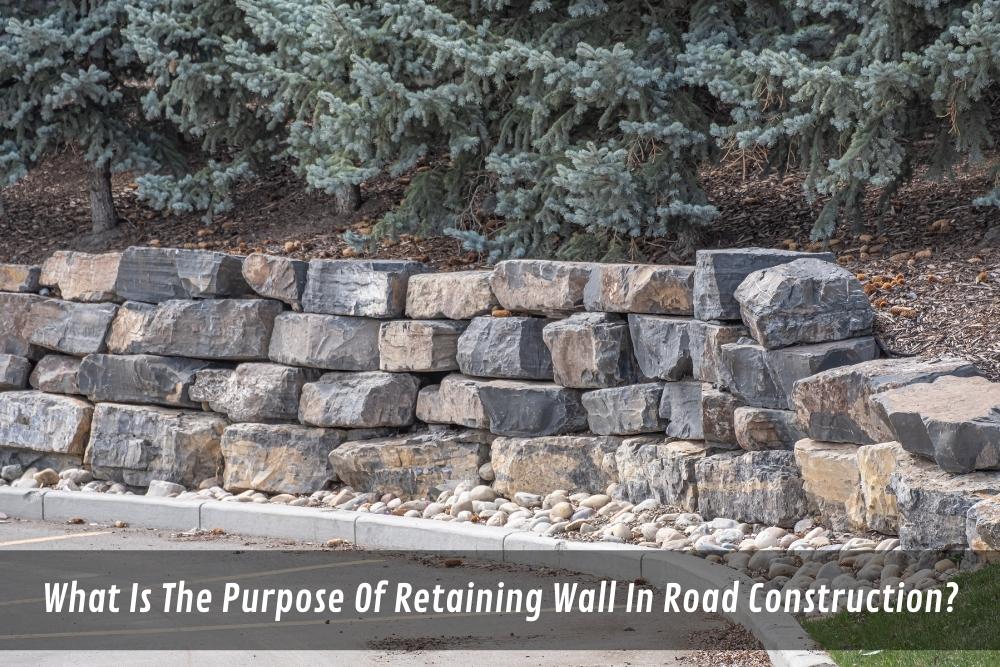Do you know the purpose of a retaining wall in road construction? Have you ever noticed tall, sturdy walls holding up roads or highways? Those are retaining walls, and they play a crucial role in road construction.
Retaining walls are structures used to hold back soil, usually located on the side of a road or highway. They have been used in construction for centuries, with evidence of their use found in ancient civilisations such as the Inca and Roman empires. In modern times, retaining walls are an essential feature of road construction projects.
In road construction, retaining walls serve a vital purpose in preserving the integrity of the road and ensuring the safety of drivers and passengers. They also play a role in managing the impact of weather and natural disasters. In this article, we will delve into the importance of retaining walls in road construction and how they function.
What are the various types of retaining walls used in road construction?
A retaining wall in road construction can be constructed using a variety of materials and structures.
- Sheet-piled wall involves inserting steel sheets into the ground at an angle to retain soil. A precast concrete wall can be used to construct a variety of shapes and sizes, such as cantilever retaining walls.
- Gravity retaining walls use rocks, blocks, or bricks to hold back soil and rely on their mass for stability. Mechanically stabilised earth (MSE) walls are constructed from layers of soil with reinforcements for additional stability.
- Anchored retaining walls use anchor plates to support their weight and prevent displacement.
- Gabion walls are another type of wall used in road construction that involves stacking large cages filled with gravel or stone along a slope.
- A reinforced concrete retaining wall is another type of wall that uses concrete with steel reinforcements to hold back the soil.
No matter what type of wall is chosen, it must be designed according to the project’s specific requirements in order to ensure its long-term stability and protection.
What are the functional benefits associated with retaining walls?
Retaining walls provide a wide range of functional benefits in road construction projects.
- They help protect the integrity of the road and its surroundings, prevent erosion, and reduce the potential for landslides or other destructive events. Moreover, retaining walls can also be used to create space for underground utilities such as water pipes or power lines. This provides increased safety by minimising the risk of damage to these important infrastructures.
- Retaining walls also help improve visibility on roads and highways by allowing drivers a clear view of upcoming curves or turns. This is especially important when driving at night or during adverse weather conditions. Additionally, taller retaining walls can be used to shield drivers from noise pollution and hazardous materials that may be present in certain areas.
- They are also an important part of road construction because they help to reinforce the surrounding soil and stabilise the ground. This prevents future settling or shifting of the roadway, which can cause major damage over time. Besides reducing future maintenance costs, retaining walls also provide additional support for heavy machinery used in road construction and repair projects.
- Another benefit that retaining walls bring to road construction projects is their versatility. Depending on the situation, they can be constructed from a variety of materials such as steel, wood, concrete blocks, bricks, gabions (wire baskets filled with stones), and precast concrete panels. This allows contractors to create unique solutions for any given project based on its specific requirements and conditions.
- Last but not least, retaining walls are also aesthetically pleasing and can be used to create attractive landscapes. This helps to improve the overall look of a road or highway, making it more appealing and inviting for drivers.
What are the factors that influence the design of retaining walls?
- The design of retaining walls must take into consideration a variety of factors, such as the type of wall, the size and weight of the retained soil, the earth pressure from the surrounding soil, and other environmental factors.
- Additionally, it is important to consider how much load the wall will need to support. For example, if heavy machinery or large vehicles will be driving over the wall, it must be designed to withstand this additional force. Additionally, certain types of walls may require specialised reinforcements such as steel bars or mesh nets in order to provide additional stability.
- A structure designed to hold back soil must also be planned according to the slope or excavation of the road it is supporting. This helps ensure that the wall remains stable and secure, preventing landslides or other damaging events.
- When designing a retaining wall for a road construction project, engineers also need to determine which type of wall is best suited for the job. For example, gravity walls are typically used for lower retaining walls, while cantilever and sheet pile retaining walls are better suited for taller applications. In addition, precast concrete panels can be used for both tall and short retaining walls, but may require additional reinforcement depending on their height.
Conclusion
All in all, retaining walls are integral components of road construction and repair projects. They provide a wide range of benefits such as improving visibility on roads, preventing soil erosion and landslides and providing additional support for heavy machinery. Additionally, they can be constructed from a variety of materials and are aesthetically pleasing, helping to improve the overall look of a road or highway.
If you need assistance with designing a retaining wall for your road construction project, contact A1 Gardening Sydney today. Our team of experts can help you determine which type of retaining wall is best suited for the job and provide you with all the necessary materials and equipment to complete the project.

